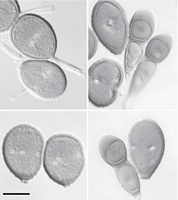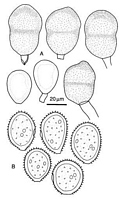|
 Puccinia chathamica Puccinia chathamica
SynonymsUredo chathamica
BiostatusPresent in region - Indigenous. Endemic
Images (click to enlarge)
Caption: Fig. 4. Urediniospores and teliospores of Puccinia chathamica McKenzie on Carex trifida Cav. (holotype). Bar 20 μm | 
Caption: Figure 1. A, Puccinia tetragoniae var. novae-zelandiae, teliospores and urediniospores
(PDD 56064 - type). B, Uredo chathamica, urediniospores (PDD 44228 - type).
Specimens mounted in hydrous lactophenol. |
Article: McKenzie, E.H.C. (1991). Puccinia tetragoniae var. novae-zelandiae var. nov. and Uredo chathamica sp. nov. from Chatham Islands, New Zealand. Mycotaxon 41(1): 307-310.
Description: Uredinia amphigenous, mainly on lower (abaxial) surface, cinnamon-brown, pulverulent,
up to 1 mm long or confluent and linear, surrounded by the ruptured epidermis.
Urediniospores (28-) 33-39 (-46) x (24-) 26-31 (-35) µm, globose or broadly ellipsoidal,
wall (1.5-) 2-3.5 (-4) µm thick, golden-brown, echinulate, germ pores 3-4, equatorial.
Notes: There are four species of rust fungi recorded on Carex in New Zealand. Urediniospores
of Uredo chathamica differ from those of the four Puccinia spp. in size and number of
germ pores. Carex chathamica is endemic to the Chatham Islands, while C. trifida, which
is indigenous to the South Island and the subantarctic islands of New Zealand, also
occurs in Chile and the Falkland Islands.
Article: McKenzie, E.H.C. (2008). Rust fungi in the subantarctic islands of New Zealand. Mycoscience 49: 1-10 Mycological Society of Japan.
Description: Uredinia amphigenous, mainly on lower (abaxial) surface, cinnamon-brown, pulverulent, linear, up to 2 mm long or longer when confluent, surrounded by the ruptured epidermis. Urediniospores 33–49 x 27–33 µm (av. of 39 spores, 41.4 x 30.0 µm), subglobose, ellipsoidal or obovoid, wall 2–3.5 µm thick, light brown, echinulate, germ pores 3, equatorial. Telia on lower (abaxial) surface, dark brown toblack, compact, up to 1 mm long, surrounded by the ruptured epidermis. Teliospores 43–56 x 18.5–21 µm, ellipsoid or subclavate, apex rounded, constricted at septum, wall 1–2.5 µm thick at sides, 9–10.5 µm at apex, smooth, light brown; pedicels up to 30 x 4–5 µm, but usually broken shorter, paleluteus.
Notes: Notes: The description of the urediniospores matches that given by McKenzie (1991) for Uredo chathamica [(28–)33–39(–46) x (24–)26–31(–35) µm], and a comparison of specimens also indicates that they are conspecific. McKenzie (1991) described U. chathamica based on four collections of a rust fungus on Carex chathamica Petrie and two on C. trifida from the Chatham Islands, New Zealand. None of the six specimens had teliospores. The collection of rust on C.trifida from Campbell Island is the only one to have both urediniospores and teliospores.
Unusually, it is the urediniospores of P. chathamica that are quite distinctive from those of four other species of Puccinia known on Carex spp. in New Zealand. The urediniospores are larger than those of the other four species (P. caricina, P. mania G. Cunn., P. maurea G. Cunn., P.rautahi G. Cunn.) and they generally have three equatorial germ pores. The teliospores are less distinctive. In size they are most similar to those of P. maurea and P. rautahi, but are slightly larger. The teliospores of P. rautahi/ have an acuminate apex whereas those of P. chathamica and P. maurea are mainly rounded.
|